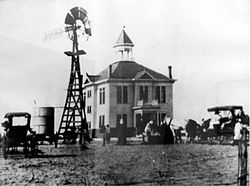Kermit, Texas | |
|---|---|
City | |
| City of Kermit | |
 Winkler County Courthouse in Kermit | |
| Nickname: | |
 Location of Kermit, Texas | |
 | |
| Coordinates: 31°51′14″N103°5′32″W / 31.85389°N 103.09222°W | |
| Country | United States |
| State | Texas |
| County | Winkler |
| Incorporated | 1938 |
| Government | |
| • Mayor | David Holbrook [1] |
| • City Manager | Frankie Davis [2] |
| • City Secretary | Diana Franco [3] |
| • Chief of Police | Jaime Ramos [4] |
| Area | |
• Total | 2.52 sq mi (6.52 km2) |
| • Land | 2.52 sq mi (6.52 km2) |
| • Water | 0 sq mi (0.00 km2) |
| Elevation | 2,861 ft (872 m) |
| Population (2020) | |
• Total | 6,267 |
| • Density | 2,577.7/sq mi (995.26/km2) |
| Time zone | UTC−6 (Central (CST)) |
| • Summer (DST) | UTC−5 (CDT) |
| ZIP code | 79745 |
| Area code | 432 |
| FIPS code | 48-39004 [6] |
| GNIS feature ID | 1360598 [7] |
| Website | www |
Kermit is a city in and the county seat of Winkler County, Texas, United States. [8] The population was 6,267 at the 2020 census. [9] The city was named after Kermit Roosevelt following a visit by his father, President Theodore Roosevelt, to the county.


